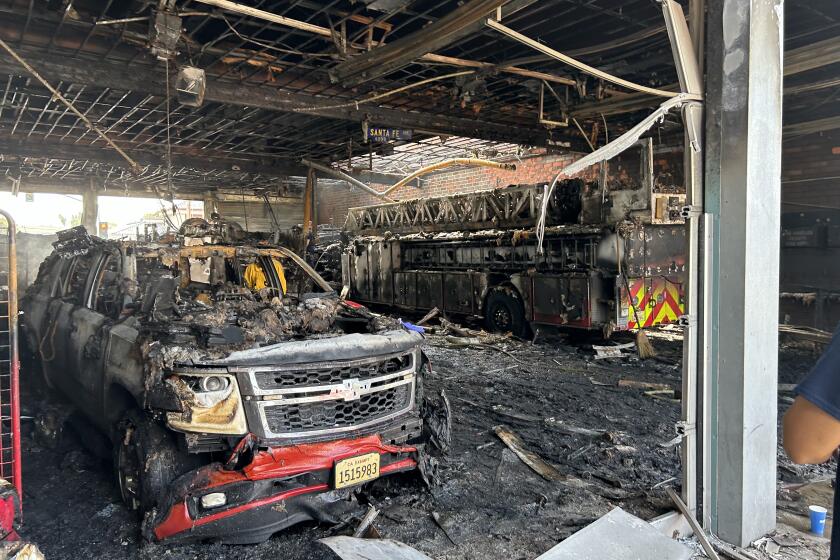L.A. Hit List on Chemical Safety Draws Criticism
The Los Angeles Fire Department has released the names of 4,000 city businesses alleged to be in violation of state law for failing to submit plans to deal with hazardous materials emergencies. But the accuracy of the list was disputed Tuesday by some of the companies on it.
A telephone survey of some of the businesses showed that their records and the Fire Department’s disagree for a variety of reasons.
Star-Kist Foods Inc., for example, was listed as failing to file a plan as of July 1, the cutoff date for the non-compliance list.
“We believe we are in compliance,” said Bill Fallon, Star-Kist vice president. “The address (in Fire Department records) is a back delivery door to an operating facility we sold in 1987.” Star-Kist “submitted a business plan to the Fire Department on Feb. 16,” Fallon said.
Just Received Notice
“We got the notice of violation today. It was the first time anybody had seen anything like this,” said John Maatta, an attorney for Lorimar Telepictures, which has a video post-production site near Los Angeles International Airport and was on the list.
“The letter was addressed to ‘Lorimar Telepictures’ with no name on it,” Maatta said. There are a couple of thousand employees. That makes it hard to track down. And we didn’t get the original letter. Or whoever did get it, didn’t respond. Or they did respond, and the Fire Department never got it.”
The state law requiring the so-called “business plan” for hazardous materials was adopted in 1985 so that firefighters could learn of special and dangerous circumstances they might encounter when fighting fires at industrial and commercial sites.
The plans must specify the kinds of chemicals stored at the site and in what amounts, a map of their locations at the facility and an evacuation plan for workers. The deadline for filing a plan was Jan. 1.
In releasing the non-compliance list to The Times, fire officials cautioned that it may not be completely accurate, although it served as the department’s mailing list for recent stern letters warning the companies to comply or face stiff fines.
“Due to the volume of plans being received. . . ,” Chief Donald O. Manning said, “we cannot guarantee the accuracy of the list.” About 40 new reports arrive each day, a fire official said. The department can process only about four or five a day, he said.
An estimated 8,000 companies are believed to be storing, using or creating hazardous materials in sufficient amounts to require an emergency plan.
The law requires businesses using hazardous materials--including such commonplace items as gasoline, cleaning fluids and tanks of oxygen--amounting to 500 pounds, 55 gallons or 200 cubic feet to file a plan and pay a fee that is used to finance the program.
Since the law went into effect, only about half the companies have filed plans. Of those filed so far, only about 50 have been thoroughly reviewed by fire officials. And fewer than a dozen have been inspected on-site and accepted, according to Battalion Chief Richard Anderson, who oversees the program.
Now that fire officials have sent warning letters to the 4,000 companies not in compliance, urging them to file by Aug. 4 or face stiff fines, an expected avalanche of plans is expected, and it could take two years to process those reports, Anderson said.
That means the task would be completed just in time for the second biennial filing deadline, when the entire process will begin again.
Some of the plans are massive documents filed in loose-leaf binders prepared by teams of safety professionals. For example, the City of Los Angeles Department of Airports has hired a private consulting firm to help with its accounting.
Others consist of a four-page “short-form” provided by the Fire Department.
And the experience of the department and the companies alike shows that the program can be a complicated, contradictory and sometimes unnecessary. The discrepancies are illustrative of the problems being faced both by the Fire Department and the companies.
For example, the Famous Amos Chocolate Chip Cookie Co.’s factory in San Fernando, listed as out of compliance, was closed last month and the operation moved to Rialto.
An official of George Bailey Hat Co. told a similar story.
“We got letters from the Fire Department . . . one in January, and one we just received,” said Vice President Chip Alexander. “We have not filed a new plan because the company was closed and is moving out of state. We closed last spring. They (Fire Department officials) knew we would be closing. The sale went through last year.”
Some Confusion
The National Guard, for instance, had no problem with preparing its plan, but it did have a problem figuring out what to do with it.
“On June 5, 1987, the National Guard sent a business response plan to the L.A. Department of Health Services,” said Carolyn Hamilton, a spokeswoman for the guard. “Then they sent another form to the L.A. Tax and Permit Division. They didn’t realize they had to send one to the Fire Department. We’re rectifying it by sending a copy of the plan to the Fire Department. There was possibly a misunderstanding.”
For some, it was clear where to send the information, but difficult to figure what to send.
“We were rather unprepared for this” said Wayne Dye, parts manager of Toyota of North Hollywood. “It’s very hard to keep up with all the new twists and turns. . . . Looks like it’s going to take a person with a degree in chemistry to fathom all this material,” he said.
” . . . We absolutely plan to comply, but we haven’t had the resources to put a full-time staff just to fill out the paper work. I’m afraid that’s what it’s going to take. It will cost several thousands of dollars,” Dye said.
Beat the Cost
At least one agency found a way to beat the high cost of preparing these plans.
The largest single non-filer, according to the list, was the Los Angeles Department of Water and Power, with 65 sites lacking a business plan.
However, according to assistant chief engineer Ken Miyoshi, the DWP has more than 260 locations in the city that required a plan and one has been filed for each.
But many of them were carbon copies of business plans prepared for simple sites such as pumping stations that may have one propane tank to fuel the machinery.
Some companies not in compliance were unaware that their common materials are also hazardous.
“Nothing (hazardous) here that I know of. We’re strictly scrap metal,” said the manager of Los Angeles Scrap Iron & Metal Co., who declined to give his name. “Until I find out exactly what is a hazardous material, I’ll need to know more.”
Auto-Related Businesses
Many of the companies not in compliance were in auto-related industries--gas stations, repair shops, body shops and dealerships that house gasoline, solvents, paints and oils.
But many of these are small businesses, not used to dealing with a government bureaucracy.
Jon Numata, part-time worker and son the owner of a West Los Angeles Texaco station, said, “The Fire Department’s been coming over and stuff. They already know we are a gas station and put oil in a special tank. We got a letter and had to pay a couple hundred dollars about two months ago, to the city or something.”
But a manager at Jerseymaid Milk Products Co., who would not identify himself, expressed what is probably the most common attitude: “I got a notice. It’s been sitting on my desk for a while. It’s going in the mail today.”
More to Read
Start your day right
Sign up for Essential California for news, features and recommendations from the L.A. Times and beyond in your inbox six days a week.
You may occasionally receive promotional content from the Los Angeles Times.






